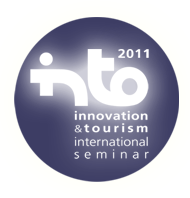






|
|
ABSTRACT DE LA PONENCIA Sr. Antoni BibiloniTourist guides are produced for smartphones; they are specialized and meet the consumer's needs. Now, their challenge is to become "personal advisors" and to move on from their more traditional role of "just providing information". To achieve this, the guides need to:✓ provide "almost automatic" personalized content per user profile ✓ provide content suited to the user's contextual environmental situation in real time (time, day of the week, weather forecast, ...) ✓ provide the user with interactivity options valid for his abilities (control by voice, etc.) ✓ define and develop as many business models as the potential relationships that exist between the distributed digital content, the users and the sector. The LetItGuide project aims to research and develop technological enhancements to the creation, publishing and dissemination of tourist guides, and to the users' interaction with this content. The technological research is centred on providing users with associated services, and not just content. These technological and organizational improvements to the value chain of digital content are going to bring in a technological strategic factor to the tourism sector: improving distribution, promotion, customer service and customer feedback tasks, in addition to creating new business models as offshoots. There is steady demand for such enhancements from the tourist sector. An example of how LetItGuide works: A user obtains a tourist guide to Mallorca, and with it is able to go through the three information phases of which a journey consists: pre-departure preparation (pre), information as and when required during the journey (in) and participation in feedback to make his opinion known (in and post (after)). The guide, through knowing the user's environmental situation, provides him with greater detail of one type of information than another. For example, in the "PRE" phase he's going to be provided with detailed information on hotels and generic information on beaches. Once he's at his destination, the same guide will switch to providing generic information on hotels and detailed information on beaches: specifically, a great deal of information on the beach to which the terminal has currently been tracked, such as where to eat out. Using the same guide, if it's eight in the evening and the user requests a restaurant, he's mainly going to be provided with restaurants that specialize in evening meals, and not eateries with lunch menus, or beach restaurants that have closed, etc.
Main researcher of the Information Technologies and Multimedia Research group
|
||||||||||||||||||||||||
| © INTO 2011 - Credits - Disclaimer - Accessibility Policy | |||||||||||||||||||||||||
